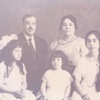Disclaimer
This entry contains information known to us from a variety of sources but may not include all the information currently available. Please be in touch if you notice any inadvertent mistakes in our presentation or have additional knowledge or sources to share. Thank you.
Archive
Moses Somake: BVS Parsi School at Karachi, Pakistan
On the 150th anniversary of the BVS Parsi High School in 2009, principal Kermin Parekh declared: “This institution is not just part of Karachi, in fact it is Karachi; a building more than 104 years, trees more than 100 years, and knowledge imparted that cannot be measured in time”.1 The building that the school has occupied for more than one hundred years was designed and built by Iraqi Jewish architect Moses Somake. Originally a vernacular school for Zoroastrian students, it was opened to students of all faiths after the partition of India, and today is one of Karachi’s elite high schools.
Description
Moses Somake Although Moses Somake’s buildings are among the most famous and recognizable in Karachi, little is known about the architect who designed them. Somake was born on June 6, 1875, possibly in Lahore. Sources describe him as an Iraqi Jew, but differ as to whether he was born in Iraq or was of Iraqi heritage but born in India. He spent most of his life in Karachi before emigrating to England in the mid 1940s, and died on April 6, 1947.2 During his years in Karachi he designed over a dozen buildings, including mansions, hotels, and a mosque that was never built.3 Many of the buildings still remain: some, including the Karachi Goan Association Hall and the BVS Parsi School, still fulfill their original purpose, while others are neglected or have fallen into disuse. Even the buildings that are virtually abandoned are still recognized as some of Karachi’s most beautiful and striking landmarks, emblematic of a style described as “hauntingly beautiful”.4 Somake’s buildings preserve the past through their uses as well as their designs, recalling the greater religious diversity that existed in Karachi in the early 20th century, when a Jewish architect could be commissioned to design a mosque, a building for a predominantly Christian club, and a school for Zoroastrian students.
History The Zoroastrian residents of Karachi opened the Parsi Balakshala on May 23, 1859, to impart knowledge of Gujrati and their religion to their children.5 In 1862, Seth Shapurji Hormusji Soparivala became the Secretary of the school; eight years later, he donated his two-storey house to be used as a coed vernacular school, named the Parsi Virbaiji School in honor of his late wife Bai Virbaiji Soparivala.6 All classes were taught in Gujrati, although an English class was added in 1875; students learned reading, writing, arithmetic, history, and geography. By the 1890s, the school had grown too large for Soparivala’s house. Seth Khurshedji Soparivala laid the foundation stone for the current school on October 10th, 1904, and commissioned Moses Somake to construct the building, which opened in March 1906.7 In 1922, the school was renamed the Bai Virbaiji Soparivala School and became a high school. After the partition of India, the school opened its doors to students of all faiths, and classes began to be taught in Urdu rather than Gujrati.8
Karachi's Jewish Community In the early 19th century, Jews of the Bene Israel communities in India migrated to Indian costal towns, including Karachi. By the 1890s, Karachi had a thriving Jewish population; the city’s Magan Shalome synagogue was constructed in 1893.9 The Jewish community played a role in shaping Karachi’s development—whether through the physical development of the city, as architect Moses Somake’s buildings transformed the landscape, but or through political influence. Two prominent members of the Jewish community in the early 20th century were heavily involved in Karachi’s government. Solomon David Omerdekar, who spearheaded the effort to construct the synagogue, held several positions in the local government, and a street named after him still exists to this day.10 Abraham Reuben served as the first Jewish city councilor, elected to the city council three times between 1919 and 1939.11 According to several accounts, Karachi in the early 20th century was a very tolerant city, with diverse religious populations coexisting peacefully.12 While the Jewish population was around 2500 at the time of partition, mass emigrations to Israel in the 1950s reduced the population to less than 300 by 1968.
Sources
[1] Dinshaw, Mehelli. Bai Virbaiji Soparivala Parsi High School, a Sesquicentennial Centenary – 150 Years from 1859 to 2009. BVS Parsi School, 2009. Accessed July 10, 2014. http://zoroastriansnet.files.wordpress.com/2011/01/bai-virbaijee-soparivala-parsi-high-school.pdf
[2] Salman, Mohammed. “Somake’s Karachi.” Dawn.com. May 22, 2011. Accessed July 8, 2014. http://www.dawn.com/news/630841/somakes-karachi
[3] Maher, Mahim. “The Jews built Karachi, but we built shopping plazas on their synagogue.” The Express Tribune. November 3, 2013. Accessed July 8, 2014. http://tribune.com.pk/story/626468/secret-histories-the-jews-built-karachi-but-we-built-shopping-plazas-on-their-synagogue/
[4] Salman. "Somake's Karachi."
[5] BVS Parsi School. “History.” Accessed July 9, 2014. http://www.bvsparsischool.edu.pk/?page_id=54
[6] Ibid.
[7] Dinshaw. Bai Virbaiji Soparivala Parsi High School, a Sesquicentennial Centenary – 150 Years from 1859 to 2009.
[8] Mehta, Shahrokh. “Memories of a Parsi/Zarathushti Youth During the Early Years of Pakistan (1940-1965).” Vohuman.org. June 17, 2006. Accessed July 10, 2014. http://www.zoroastrian.org.uk/vohuman/Article/Memories%20of%20a%20Parsi-Zarathushti%20Youth%20During%20the%20Early%20Years%20of%20Pakistan%20%281940-1965%29.htm#_edn1
[9] Ghosh, Palash. “Karachi Yahudi: Pakistan’s vanishing (or vanished) Jewish community.” International Business Times. November 16, 2013. Accessed July 9, 2014. http://www.ibtimes.com/karachi-yahudi-pakistans-vanishing-or-vanished-jewish-community-1472832
[10] Ibid.
[11] Ibid.
[12] Ibid.






![BVS Parsi School, Chemistry Lab [2] (Karachi, Pakistan, n.d.)](https://cdn.filestackcontent.com/0MTNNyLNRqOsjtXfdwVz/convert?w=100&h=100&fit=crop)
![BVS Parsi School, Chemistry Lab [1] (Karachi, Pakistan, n.d.)](https://cdn.filestackcontent.com/jtlX3ICIRFCW2rs5PrnN/convert?w=100&h=100&fit=crop)



